PONTIAC GRAND-AM 1995 Owners Manual
Manufacturer: PONTIAC, Model Year: 1995, Model line: GRAND-AM, Model: PONTIAC GRAND-AM 1995Pages: 354, PDF Size: 17.81 MB
Page 241 of 354
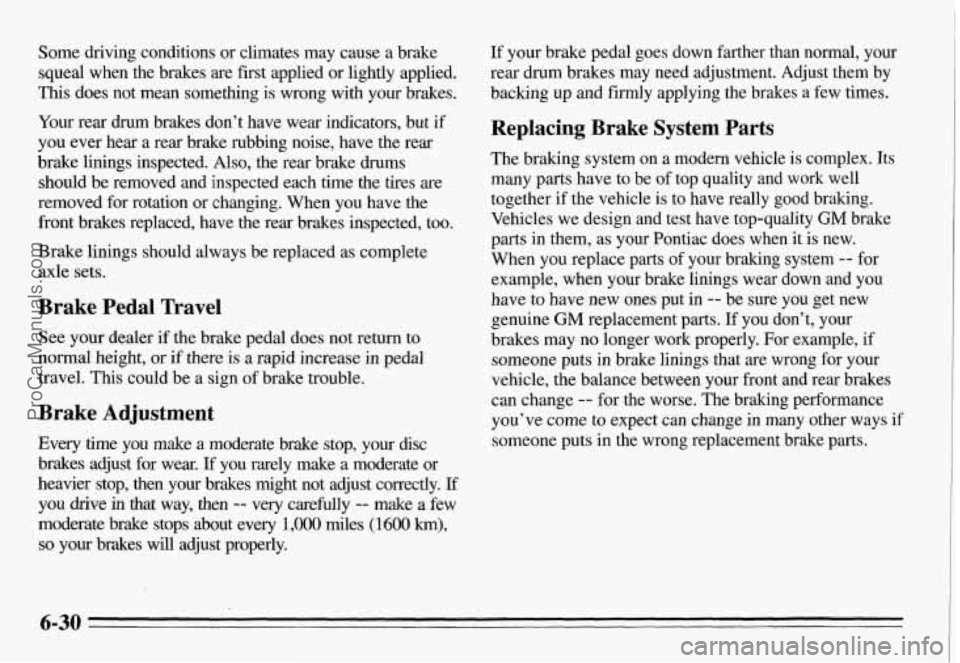
Some driving conditions or climates may cause a brake
squeal when the brakes
are fiist applied or lightly applied.
This does not mean something is wrong with your brakes.
Your rear drum brakes don’t have wear indicators, but if
you ever hear a
rear brake rubbing noise, have the rear
brake linings inspected. Also, the rear brake drums should be removed and inspected each time the tires are
removed for rotation or changing. When you have the front brakes replaced, have
the rear brakes inspected, too.
Brake linings should always be replaced as complete
axle sets.
Brake Pedal Travel
See your dealer if the brake pedal does not return to
normal height, or if there
is a rapid increase in pedal
travel.
This could be a sign of brake trouble.
Brake Adjustment
Every time you make a moderate brake stop, your disc
brakes adjust for wear.
If you rarely make a moderate or
heavier stop, then your brakes might not adjust correctly.
If
you drive in that way, then -3 very carehlly -- make a few
moderate brake stops about every
1,000 miles (1600 km),
so your brakes will adjust properly.
If your brake pedal goes down farther than normal, your
rear drum brakes may need adjustment. Adjust them
by
backing up and firmly applying the brakes a few times.
Replacing Brake System Parts
The braking system on a modern vehicle is complex. Its
many parts have to be of top quality and work well
together
if the vehicle is to have really good bralung.
Vehicles we design and test have top-quality
GM brake
parts in them, as your Pontiac does when it is new.
When you replace parts of your braking system
-- for
example, when your brake linings wear down and you
have to have new ones put in
-- be sure you get new
genuine
GM replacement parts. If you don’t, your
brakes may no longer work properly. For example, if
someone puts in brake linings that are wrong for your
vehicle, the balance between your front and rear brakes
can change
-- for the worse. The braking performance
you’ve come to expect can change in many other ways
if
someone puts in the wrong replacement brake parts.
6-30
ProCarManuals.com
Page 242 of 354
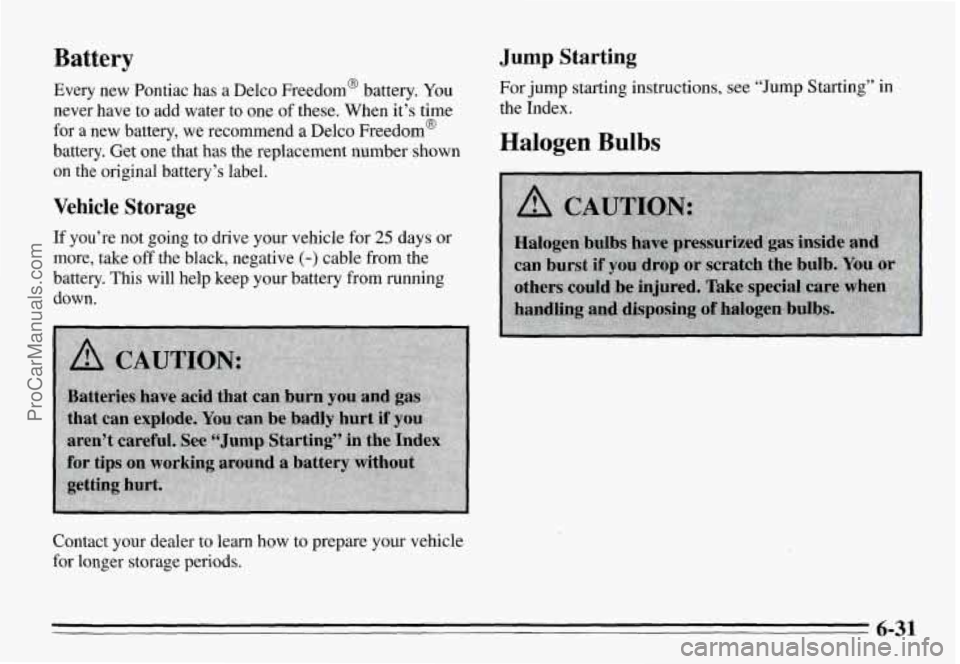
Battery
Every new Pontiac has a Delco Freedom@ battery. You
never have to add water to one of these. When it’s time
for a new battery, we recommend a Delco Freedom@
battery. Get one that has the replacement number shown
on the original battery’s label.
Vehicle Storage
If you’re not going to drive your vehicle for 25 days or
more,
take off the black, negative (-) cable from the
battery. This will help keep your battery from running
down.
Contact your dealer to learn how to prepare your vehicle
for longer storage periods.
Jump Starting
For jump starting instructions, see “Jump Starting” in
the Index.
Halogen Bulbs
n burst if you drop or scratch the bulb.
6-31
ProCarManuals.com
Page 243 of 354
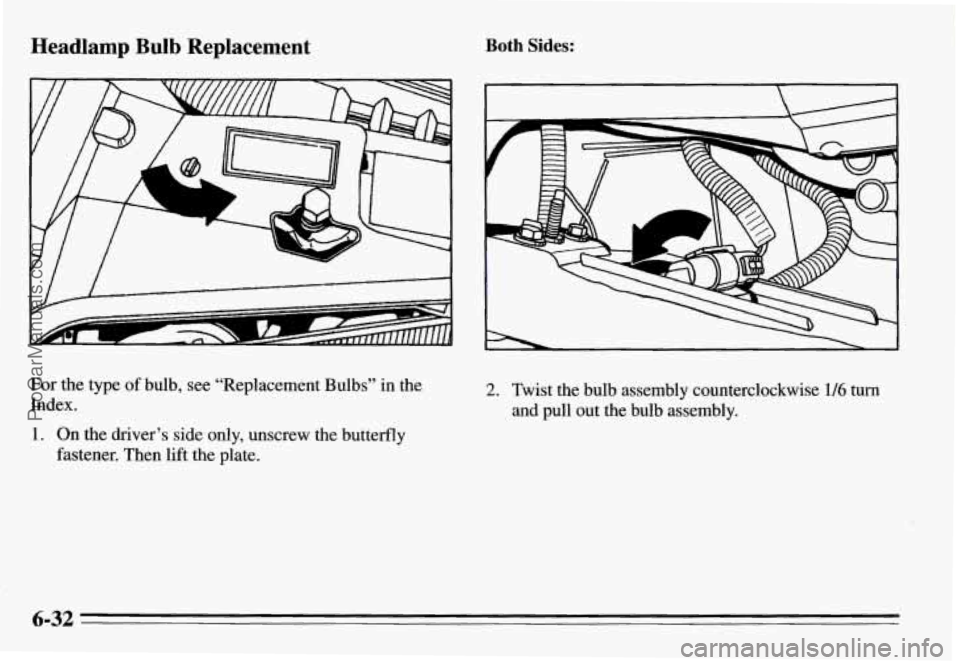
Headlamp Bulb Replacement
For the type of bulb, see “Replacement Bulbs” in the
Index.
1. On the driver’s side only, unscrew the butterfly
fastener. Then lift the plate.
Both Sides:
2. Twist the bulb assembly counterclockwise 1/6 turn
and pull out the bulb assembly.
6-32
ProCarManuals.com
Page 244 of 354
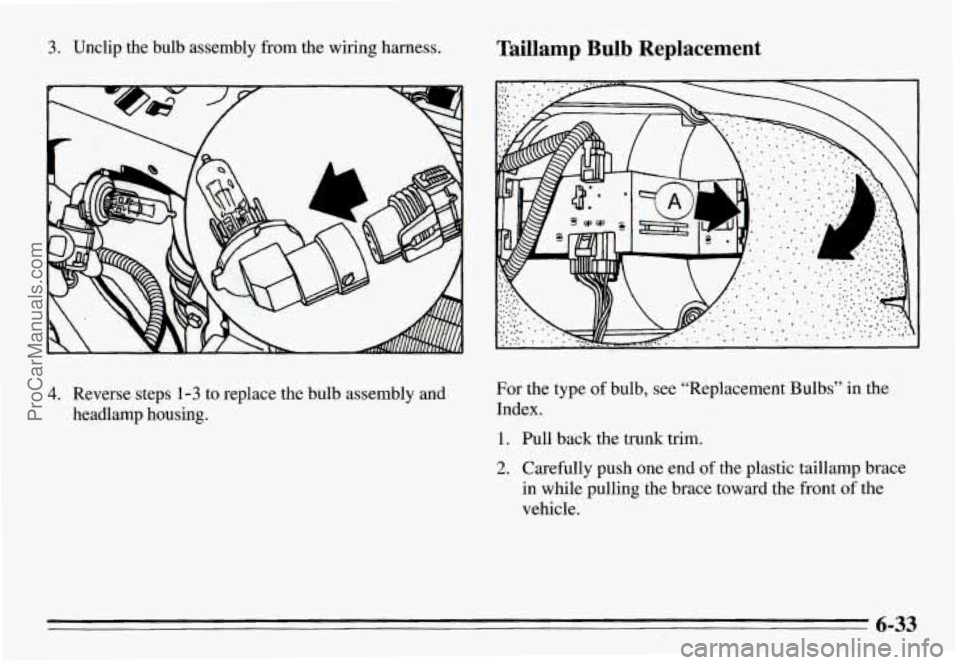
3. Unclip the bulb assembly from the wiring harness.
4. Reverse steps 1-3 to replace the bulb assembly and
headlamp housing.
Taillamp Bulb Replacement
For the type of bulb, see “Replacement Bulbs” in the
Index.
1. Pull back the trunk trim.
2. Carefully push one end of the plastic taillamp brace
in while pulling the brace toward the front of the
vehicle.
6-33
ProCarManuals.com
Page 245 of 354
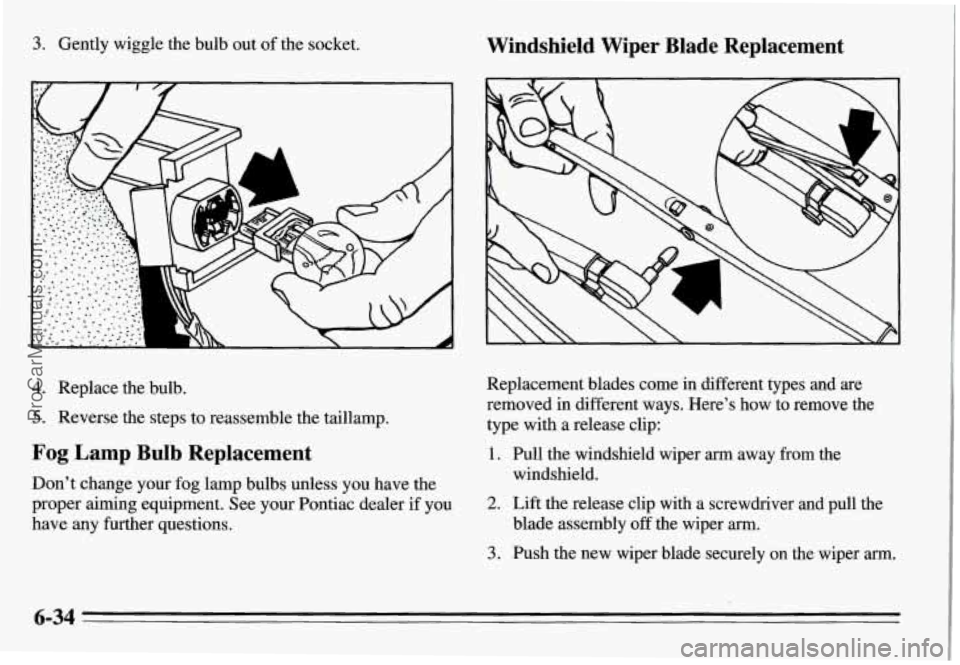
3. Gently wiggle the bulb out of the socket. Windshield Wiper Blade Replacement
Replacement blades come in different types and are
removed in different ways. Here’s how to remove the
type with a release clip:
1. Pull the windshield wiper arm away from the
windshield.
4. Replace the bulb.
5. Reverse the steps to reassemble the taillamp.
Fog Lamp Bulb Replacement
Don’t change your fog lamp bulbs unless you have the
proper aiming equipment. See your Pontiac dealer
if you
have any further questions. 2. Lift the release clip with a screwdriver and pull the
3. Push the new wiper blade securely on the wiper arm.
blade assembly off the wiper arm.
6-34
ProCarManuals.com
Page 246 of 354
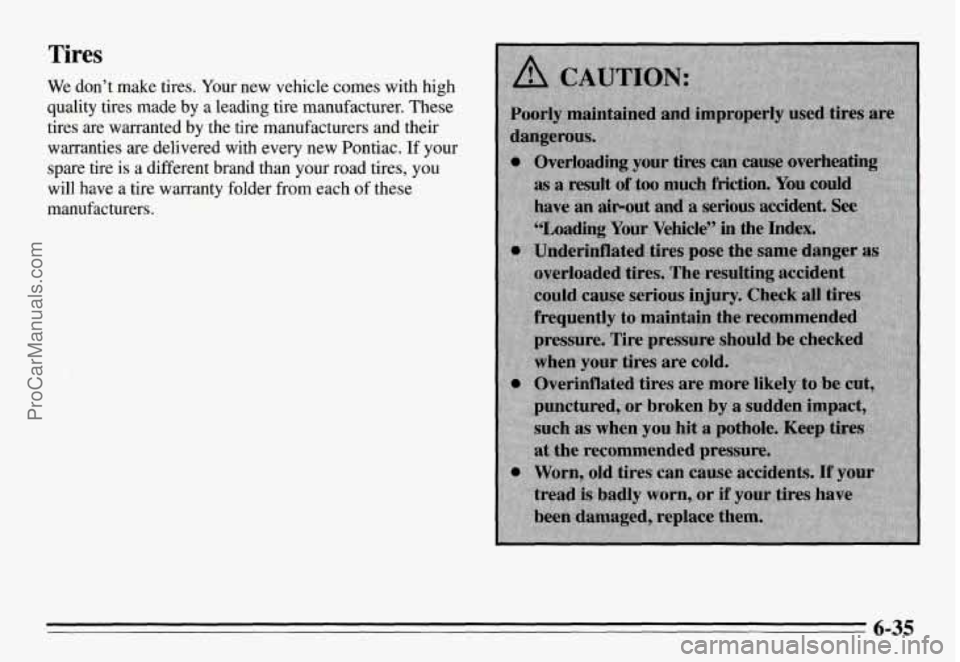
Tires
We don’t make tires. Your new vehicle comes with high
quality tires made by a leading tire manufacturer.
These
tires are warranted by the tire manufacturers and their
warranties are delivered with every new Pontiac.
If your
spare tire is a different brand than your road tires, you
will have a tire warranty folder from each of these
manufacturers.
6-35
ProCarManuals.com
Page 247 of 354
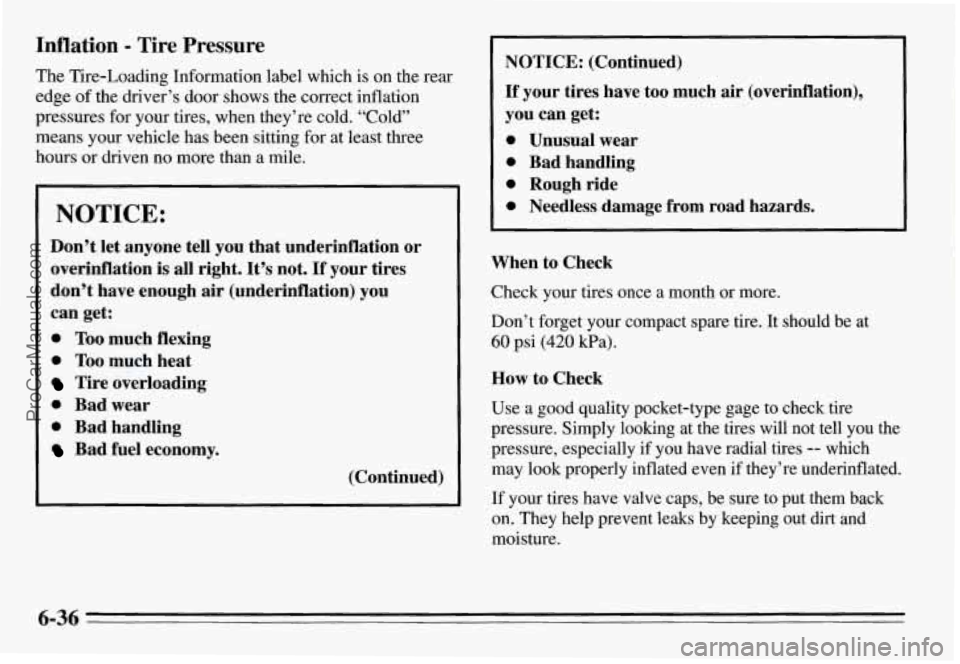
Inflation - Tire Pressure
The Tire-Loading Information label which is on the rear
edge of the driver’s door shows the correct inflation
pressures for your tires, when they’re cold. “Cold”
means your vehicle has been sitting for at least three
hours or driven no more than a mile.
I NOTICE:
Don’t let anyone tell you that underinflation or
overinflation
is all right. It’s not. If your tires
don’t have enough
air (underinflation) you
can get:
0 Too much flexing
0 Too much heat
Tire overloading
0 Bad wear
0 Bad handling
Bad fuel economy.
(Continued)
1 NOTICE: (Continued)
If your tires have too much air (overinflation),
you can get:
0 Unusual wear
0 Bad handling
0 Rough ride
0 Needless damage from road hazards.
When to Check
Check your tires once a month or more.
Don’t forget your compact spare tire. It should be at
60 psi (420 Wa).
How to Check
Use a good quality pocket-type gage to check tire
pressure. Simply looking at the tires will not tell you the
pressure, especially if you have radial tires
-- which
may look properly inflated even if they’re underinflated.
If your tires have valve caps, be sure to put them back
on. They help prevent leaks by keeping out dirt and
moisture.
6-36
ProCarManuals.com
Page 248 of 354
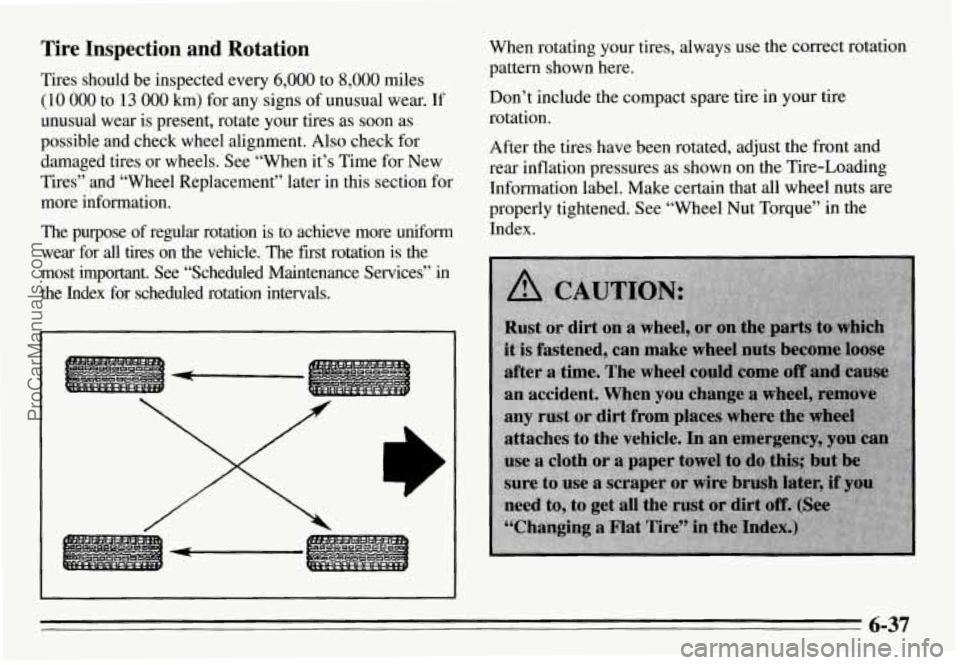
Tire Inspection and Rotation
Tires should be inspected every 6,000 to 8,000 miles
(1 0 000 to 13 000 km) for any signs of unusual wear. If
unusual wear is present, rotate your tires as soon as
possible
and check wheel alignment. Also check for
damaged tires or wheels. See “When it’s Time for New
Tires”
and “Wheel Replacement” later in this section for
more information.
The purpose of regular rotation is to achieve more uniform
wear for all tires on the vehicle. The first rotation is the
most important.
See “Scheduled Maintenance Services” in
the Index for scheduled rotation intervals.
When rotating your tires, always use the correct rotation
pattern shown here.
Don’t include the compact spare tire in your tire
rotation.
After the tires have been rotated, adjust the front and
rear inflation pressures as shown on the Tire-Loading
Information label. Make certain that all wheel nuts are
properly tightened. See “Wheel Nut Torque” in the
Index.
6-37
ProCarManuals.com
Page 249 of 354
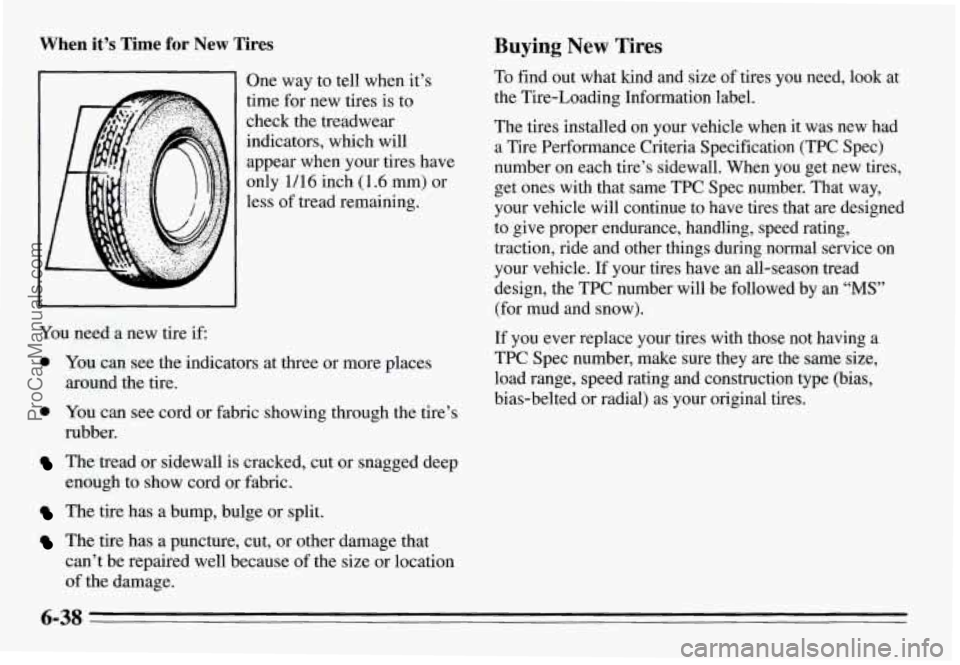
When it’s Time for New Tires
One way to tell when it’s
time for new tires is
to
check the treadwear
indicators, which will appear when your tires have
only
1/16 inch (1.6 mm) or
less of tread remaining.
You need a new tire if
0 You can see the indicators at three or more places
around the tire.
0 YOU can see cord or fabric showing through the tire’s
rubber.
The tread or sidewall is cracked, cut or snagged deep
enough to show cord or fabric.
The tire has a bump, bulge or split.
The tire has a puncture, cut, or other damage that
can’t be repaired well because of the size or location
of the damage.
Buying New Tires
To find out what kind and size of tires you need, look at
the Tire-Loading Information label.
The tires installed on your vehicle when it was new had
a Tire Performance Criteria Specification (TPC Spec)
number on each tire’s sidewall. When you get new tires,
get ones with that same TPC Spec number. That way,
your vehicle will continue to have tires that are designed
to give proper endurance, handling, speed rating,
traction, ride and other things during normal service on your vehicle. If your tires have an all-season tread
design, the TPC number will be followed by an
“MS”
(for mud and snow).
If you ever replace your tires with those not having a
TPC Spec number, make sure they are the same size,
load range, speed rating and construction type (bias,
bias-belted or radial) as your original tires.
6-38
ProCarManuals.com
Page 250 of 354
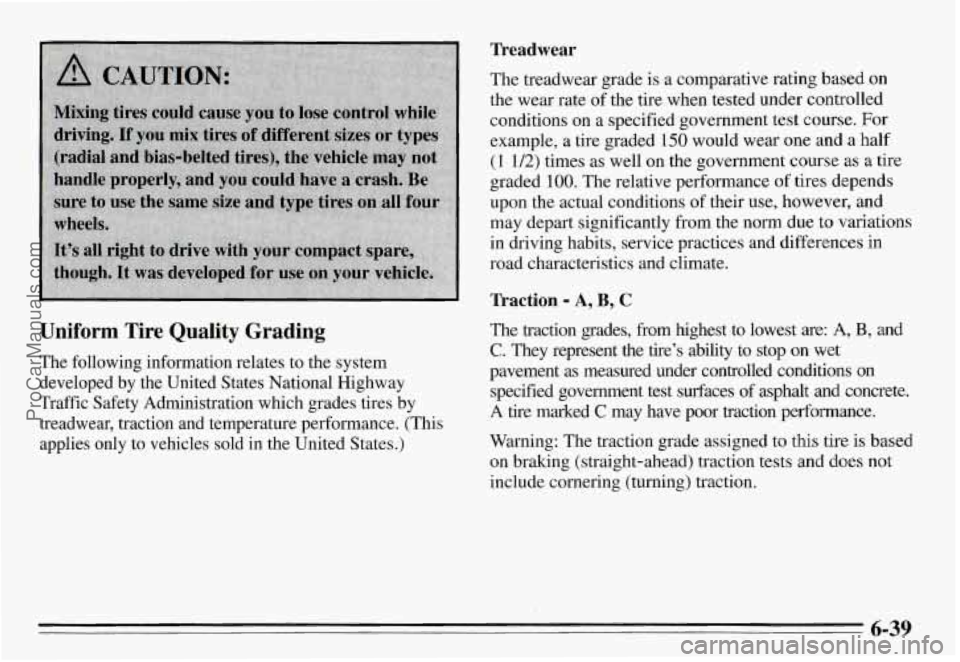
I
It’s all right to drive with your compact spar
though.
It was developed for use on Your vehicl
The following information relates to the system
developed by the- United
States National Highway
Traffic Safety Administration which grades tires by
treadwear, traction
md temperature performance. (This
applies-only to vehicles sold in the United States-)
Treadwear
The treadwear grade is a comparative rating based on
the wear rate of the tire when tested under controlled
conditions on a specified government test course. For
example, a tire graded
150 would wear one and a half
(1 1/2) times as well on the government course as a tire
graded
100. The relative performance of tires depends
upon the actual conditions of their use, however, and
may depart significantly from the norm due to variations
in driving habits, service practices and differences in
road characteristics and climate.
Traction - A, B, C
The traction grades, from highest to lowest are: A, B, and
C. They represent the tire’s ability to stop on wet
pavement as measured under controlled conditions on specified government test surfaces of asphalt and concrete.
A tire marked C may have poor traction performance.
Warning: The traction grade assigned to this tire is based
on braking (straight-ahead) traction tests and does not
include cornering (turning) traction.
6-39
ProCarManuals.com